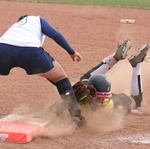questions on football 2
Question
Sorry I also forgot to ask, I'm also interested in some of the questions that you posted up
1. How can I develop better technique as a wide receiver and defense back?
2. How can I read the defense better?
3. I'm a pretty fast person, but how can I develop better catching skills?
Thanks again for your time Coach.
-Steve
Answer
Dear Steve:
You can ask as many questions as you would like. No problem. I am happy to help.
Receiving a Pass
- Form a triangle with your hands (between your index fingers and thumbs)
- Keep your eye on the ball at all times
- Keep the ball away from your body
- Keep your hands soft so that you can cushion the ball
- Once you have caught the ball, tuck it away so that you don't fumble it.
There are 3 characteristics a receiver must have. A receiver must demonstrate a strong ability to block the other guy, consistently get opened on pass patterns, and he must be able to prove (time and time again, to all) that he has sure-hands. If you can consistently turn a third-down into a first-down you will be the go to guy on any team.
Let us start with blocking; blocking is nothing more than hard work and never giving up. What you need to do is spend some time in the weight room (during the summer) this will make you stronger.
I would also work on my conditioning and my ability to react to the ball. Playing a lot of handball and basketball will help you develop these skills. Handball and basketball will make you quicker and better conditioned.
Next, I would work on pass patterns. A receiver must get opened before he can catch the ball. I would work on the quick out, slant, and the seam pass. These quick patterns are a must have on most teams. And great tight end patterns.
Remember when running your patterns, the biggest mistake you can make is to slow down when catching the ball or after making your break. If you slow down before you catch the ball or after your break, you will be giving the defensive back time to catch up with you.
You must run your pattern as fast as you can, while still keeping under control, and let the quarterback lead you. It is up to the quarterback to get you the ball when you are open.
Quick Out (1):
This is a 5-8 yard route forward then the receiver cuts out towards the sideline then looks for the ball.
Slant (2):
This is a 3-5 yard route forward then the receiver breaks towards the middle of the filed on a 45 degree angle and looks for the ball.
Seam (3):
This route is run straight up the field with the receiver looking for the ball after he gets past the line of scrimmage.
The most important skill that a receiver can master is strong desire to catch the ball. A receiver should concentrate on looking the ball into his hands (all the way into his hands).
A receiver must be able to shut everything out of his mind by focusing all his attention on looking the ball into his hands.
A receiver must watch the football until he catches it and puts it away before he starts to run with it. The catch is more vital than the run after.
The last twelve inches of the flight, of the ball, are the most important of all, this is where most receivers take their eyes off the ball and drop it.
Here is a list of drill you can work on. You will need someone to play quarterback. All passes will be no longer than 3-5 yards at first. When you get good, at catching the ball, at this distance, move up to 8-10 yards.
1. Have the quarterback throw the ball over your left shoulder (catch the ball with your right hand only) 5-10 passes per-practice.
2. Have the quarterback throw the ball over your right shoulder (catch the ball with your left hand only) 5-10 passes per-practice.
3. Two handed catch over your right shoulder (5-10 times).
4. Two handed catch over your left shoulder (5-10 times).
Always catch the ball with your hands only (do not trap the ball against your body it will bounce off your shoulder pads. Try this for about a week or two, 20-30 minutes a day. Short passes only. At first you will drop a lot of passes but don't give up. When you are ready, move on to (a little) longer passes.
Before you start any program, make sure to get all the help you can from people that care about you and want you to succeed. They can make sure that you do not over do it and that you reach your goals.
If I were you I would work on my pattern reading. Here is a simple system you can use to add pattern reading to your defense.
1. Spend some time looking at the game film of your next opponent and learn his play book.
2. Make a list of your opponents pass plays, and place the pass plays into five sets, short passes, medium passes, long passes, inside patterns, and outside patterns.
3. Now make these groups even smaller by dividing them into sub-groups that include passes by formation, downs, tendencies, inside patterns, outside patterns, and distance. This will give you an idea what to look for in every situation.
Here is a simple tip if you don't want to work that hard to read the offense. The biggest tip I can give you comes from the receiver himself. Watch the receiver carefully on the game films. A lot of the receivers make the same mistakes. When a receiver is running an inside pattern he will release inside shoulder of the corner back. When a receiver is running an outside pattern he will release outside shoulder of the corner back.
Here is where knowing your opponents play book comes in handy. Let us say that it is third and 10. And let us say that the receiver takes an outside release. You know that your opponent has three pass patterns they like to run to the outside. They like to run a 3-yard hitch, a 5-yard out, and 12-yard flag pattern. Can you guess which pattern they are going to run? The hitch and the short out pattern will not give them a first down but the 12-yard out pattern will.
Now that you know all this you can play the percentage game. The odds are now in your favor to make the big play. Here is where the pattern reading comes in.
Pattern reading is nothing more than a combination of landmark dropping and reading the receivers routes. In fact, defensive backs must know their landmark drops before they can move up to the pattern reading level.
A pattern reading is a simple read of the second receiver from the sidelines. For example, many teams, on the high school level, usually have their tight end run a short pattern while the slot-back will run a deeper route. By reading the tight end's pattern, you will have a good idea of what the slot-back is going to do. The same goes for the two receiver set. One receiver will usually run a short pattern while the other will go deep. If you know what combination patterns the two receivers run, by doing your homework, you will be waiting for the ball when it is thrown.
The information I gave you is gold and I hope you guard it well. I presume this answers your question. If not, please let me know and I will do my best to help you.
Your friend, Coach Louis
Fullback and Linebacker
Weighing and approving game ball


